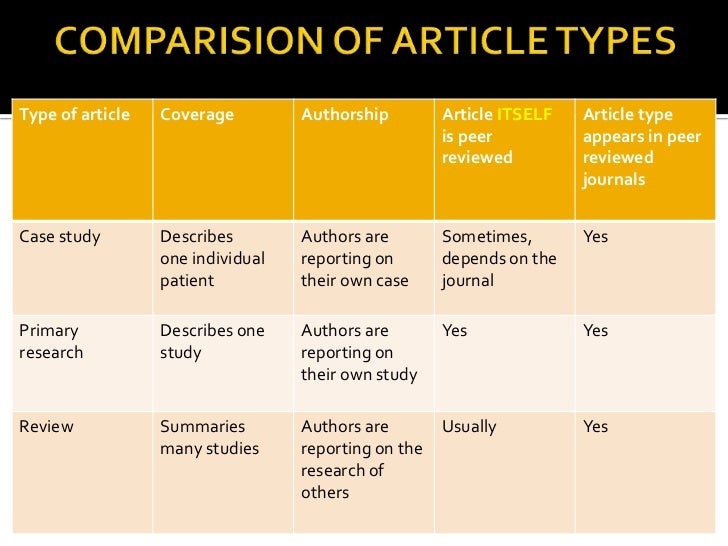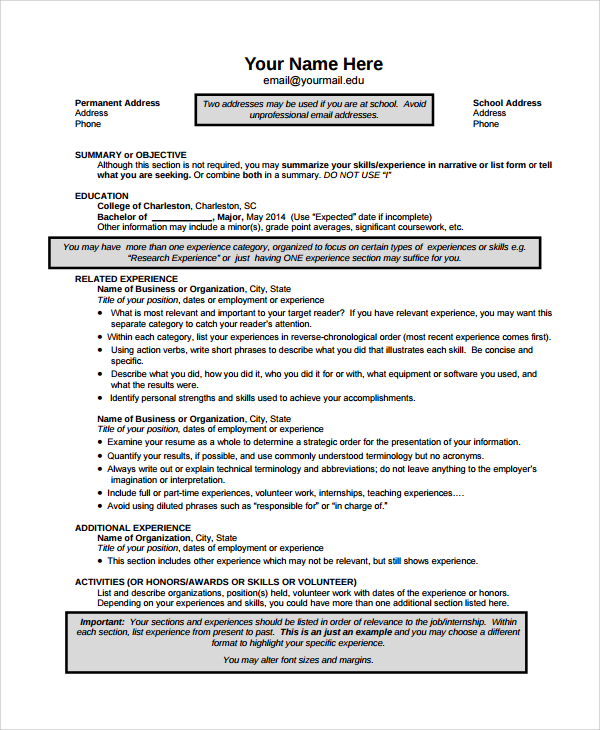
4/19/ · Types of Review Articles (Literature, Scoping and Systematic) Research Methods (Designing your own research; calculating statistics) Find Books; Guidelines; Critical Appraisal; Images; Writing/Citing Toggle DropdownAuthor: Caitlin Carter 10/2/ · Review papers tend to include both quantitative (i.e., meta-analytic, systematic reviews) and narrative or more qualitative components; together, they provide platforms for new conceptual frameworks, reveal inconsistencies in the extant body of research, synthesize diverse results, and generally give other scholars a “state-of-the-art” snapshot of a domain, often written by topic experts Cited by: 10/21/ · There are three main types of articles review that you can be asked to write during a college course: Narrative. This type requires studying the author's experience. The expert's theories and methods have to be analyzed and compared. The key to writing a successful narrative review is to provide qualitative and logical arguments. Evidence
Home - Systematic Reviews: the process - LibGuides at Duke University Medical Center
Conventional systematic reviews address narrowly focused questions: their key contribution is summarizing data. Narrative reviews provide interpretation and critique; their key contribution is deepening understanding.
Literature reviews can have a variety of purposes and various forms, and they are based on different search strategies. Some PhD students may write a systematic review as part of their PhD project. On this page, you will learn about two main types of literature reviews. Narrative reviews 2.
Systematic reviews These types are often understood to be at either end of a continuum of literature reviews. The narrative review, which Hart terms scholastic, is intended to deepen the understanding of a body of literature, types of review articles.
The systematic review has the potential of being interventionistic because it can aid in decision making in many areas and levels of society. The narrative review is the classic literature review and is a long-standing tradition in research. Today it is the most common form of review in the humanities and parts of social sciences.
The important contribution of a narrative review is the author´s interpretation and critique of the literature under scrutiny in the review. A narrative review can examine many topics; one would expect the narrative reviewer to read widely and use literature from types of review articles subject disciplines. In this type of review, it would be possible, types of review articles, and maybe even expected, to include historical and philosophical perspectives.
The literature included in such a review may be in any format; one can therefore include books and grey literature as well as journal articles. Investigation in a narrative review is iterative and for each re-reading of the literature the interpretation should be deepened. According to Hartp. The systematic review is a methodical approach in order to collect, appraise and synthesize all available research and data relevant to a predefined research question.
In contrast to narrative approaches, systematic reviews are based on documented, transparent and reproducible searches, building on the same principles as other aspects of empirical research.
They are predominantly used in evidence-based health care, medicine and the life sciences, but are increasingly being adopted in other academic disciplines like psychology, education and social science.
Statistical methods meta-analysis may or may not be used to analyze and summarize the results of the included studies. The role of the systematic review is to examine the evidence across multiple individual studies with similar research questions to arrive at some conclusion about our previous knowledge. A systematic review ideally examines all previous research concerning the research question. The search methodology is extensive, and follows predefined rules. The common stages in a systematic review are:.
The key in the systematic approach is, simply put, to predefine what you are looking for. Although you are looking for all previous research, there must be enough commonalities among the studies to make comparisons that will aid your conclusion.
You will be looking for studies that address the same research question, have similar samples and sampling methods, involve similar interventions, expositions, experiments or techniques, and use similar research methods. The search will usually try to capture as much literature as possible that is relevant to the research question, while inclusion and exclusion criteria will be used to reduce the amount of studies and keep the relevant ones.
Documentation of the search will make the review types of review articles replicable for other researchers. The quality assessment will help to determine the strength of the evidence.
The term systematic review covers a wide variety of reviews that are systematic in different ways, as exemplified in the following section. The classic systematic review The classical approach to systematic reviews aims to summarize and draw conclusions based on the research related to a research types of review articles. The material is previous original studies, both published and unpublished.
The process requires two reviewers to perform the review. Importantly, the search strategy is reported, types of review articles, there are clear inclusion and exclusion criteria, and the included studies are quality assessed.
Statistical methods, or a meta-analysis using statistics to integrate results from several studies, may or may not be used in a systematic review The PRISMA Group, Umbrella reviews An umbrella review is a synthesis of findings from several reviews. A quality assessment of the reviews is performed. Ongoing research is often included. Typically, however, quality assessment is not performed. The scoping review shares some features with the systematic review, being systematic, transparent and replicable, types of review articles, but cannot be used to recommend policy or practice.
As a scoping review can be used to identify research gaps, types of review articles, it is sometimes used as a method to decide whether a full systematic review is needed or not. Scoping reviews types of review articles a relatively new but increasingly common approach for mapping broad topics Pham et al.
Meta-analysis A meta-analysis statistically combines and analyses quantitative studies. The goal can be to integrate, summarize, types of review articles, or organize. The statistical data from the included studies will have a types of review articles research question and methodology, which is necessary for the validity types of review articles the meta-analysis, types of review articles.
In this way, ìSmall or inconclusive studies lacking in statistical significance can nevertheless make a contribution to the larger picture. Note that not all studies using the meta-analysis method are systematic reviews. Rapid reviews A rapid version of the systematic review, based on the need for evidence-based decisions within a policymaker¥s time frame.
Some of the stages will be limited: ìThe methodology identifies several legitimate techniques that may be used to shorten the timescale. Qualitative systematic reviews In recent years, we have seen types of review articles increased interest in conducting systematic reviews of qualitative research.
A systematic review of qualitative research would usually be referred to as a meta-synthesis. There are several methods used for synthesizing qualitative research, and one of the best known is the meta-ethnography developed by Noblit and Hare A qualitative synthesis should be conducted using qualitative research methods Malterud, A more comprehensive list of review types can be found in Grant and Booth's article from As the field of systematic reviews has developed, useful resources have developed alongside it.
We find handbooks and guidelines on the relevant methodology from specialist institutions such as the Cochrane Collaboration. In addition, there are databases and registries devoted to finding reviews and protocols for reviews in progress.
Of special interest to review authors are reporting guidelines, as following these will increase the chances of having your review published. Here we have collected well-known resources on methodology, reporting guidelines, databases and protocol registries, types of review articles. Methodology A number of manuals and handbooks have been written to help the researcher to create a well-developed systematic review.
Systematic reviews may also be found in bibliographic databases. Here you can find them by searching extensively in several reference databases, utilizing the review filter, or by using the search terms "review", "overview", or "meta-analysis" in the title or abstract. In medicine and health, there are international registers of protocols for systematic reviews. These also record planned systematic reviews in order to prevent duplication of work.
A multilingual database of health evidence. Arksey, H, types of review articles. Scoping studies: towards a methodological framework.
International Journal of Social Research Methodology, types of review articles, 8 1 Systematic approaches to a successful literature review 2nd ed. Los Angeles, CA: Sage. Daudt, H. Enhancing the scoping study methodology: A large, inter-professional team's experience with Arksey and O'Malley's framework. BMC Medical Research Methodology, 13 1. Assembling the pieces of a systematic review : a guide for librarians.
Grant, M. A typology of reviews: an analysis of 14 review types and associated methodologies. Health Information and Libraries Journal26 2 Greenhalgh, T, types of review articles. Time to challenge the spurious hierarchy of systematic over narrative reviews? European Journal of Clinical Investigatione Literature searches and reference management. Laake, H. Olsen Eds. Amsterdam: Elsevier. Hart, C. Doing a literature review: releasing the research imagination 2nd ed, types of review articles.
Malterud, K. Kvalitativ metasyntese som forskningsmetode i medisin og helsefag. Oslo: Universitetsforlaget Moher, D. for types of review articles PRISMA Group Preferred reporting items for systematic reviews and meta-analyses: The PRISMA statement.
PLoS Medicine 6 7 : e All in the family: systematic reviews, rapid reviews, scoping reviews, realist reviews, and more. Systematic Reviews, 4 1 Meta-ethnography: synthesizing qualitative studies. Newbury Park, CA: Sage Publications.
Pham, M.
Types of Reviews
, time: 11:25Review article - Wikipedia
10/21/ · There are three main types of articles review that you can be asked to write during a college course: Narrative. This type requires studying the author's experience. The expert's theories and methods have to be analyzed and compared. The key to writing a successful narrative review is to provide qualitative and logical arguments. Evidence 4/19/ · Types of Review Articles (Literature, Scoping and Systematic) Research Methods (Designing your own research; calculating statistics) Find Books; Guidelines; Critical Appraisal; Images; Writing/Citing Toggle DropdownAuthor: Caitlin Carter 4/15/ · Tags: integrative review, living systematic review, meta-analysis, mixed methods review, network meta-analysis, overview of reviews, qualitative review, rapid review, scoping review, Systematic Review, systematic review service, umbrella reviewAuthor: Stephanie Roth

No comments:
Post a Comment